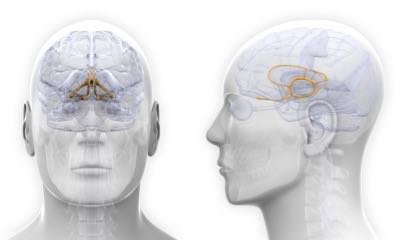Master Your Mood: The Science Behind the Types of Mood

Mood can be hard to predict. It may seem like the product of circumstance or experience. But your mood and mood triggers are much more complex. Stressors spark an emotional response in the body with the help of neurotransmitters (brain chemicals that carry messages) and hormones. So, brain chemistry is just as responsible for your emotions and types of mood as life events.
Learn how emotions are created in your brain. And give yourself the tools you need to master your mood.
Memory and Mood Triggers: The Anatomy of the Limbic System

The brain is a powerful, multi-functional organ. It has a lot of work to do all at once because it’s your body’s command center. Each area houses specialized brain cells (neurons) that perform certain tasks. The section of brain in charge of mood is located at the core—right in the middle of all the activity. It’s called the limbic system.
This network of neurons houses your emotional center and is responsible for managing your mood. The location of the limbic system is essential to its function. Many pieces of the brain work together in the limbic system. Most notable are the hippocampus and amygdala.
Hippocampus
The hippocampus is located at the center of the brain and branches into both hemispheres. The word hippocampus means “sea horse” in Greek and is thought to refer to its unique shape. While its shape may have little to do with its function, your memory has everything to do with the hippocampus. That’s because long-term memories are stored there.
The tie to long-term memory makes the hippocampus crucial to learning. In this part of the brain, bits and pieces of short-term memory are consolidated and stored away. Sensory information, like taste and smell, is bound to long-term memory in the hippocampus. This link is strengthened as the events associated with taste or smell are repeated.
Smells are the most effective at recalling information from long-term memory. Distinctive scents can remind you of places you’ve visited or people you know. Experiencing smells linked to positive memories can even elevate your mood.
Take, for instance, the smell of your mother’s perfume. After a hug or a kiss from your mom you can smell her perfume strongly. You also feel her love when she shows you how much she cares for you.
The next time you go shopping at a department store, you walk passed a vendor selling the same fragrance your mother wears. Just a whiff of that perfume can be enough to evoke the memory of the last time you were with your mom. That is because your brain has tied the scent of her perfume to your memory of her.
Remembering your mother and how much she loves you puts you in a better mood. All thanks to your hippocampus and the inner workings of your limbic system.
Neurogenesis (creation of brain cells from stem cells) also takes place in the hippocampus. New brain cells maintain brain plasticity and help you learn new things. As brain cells are formed, so are opportunities for your hippocampus to link sensory information to what you learn.
Amygdala
The amygdala sits next to the hippocampus and also influences memory. But the amygdala doesn’t tie sensory information to memories. It links emotions.
The amygdala gauges how memories are stored based on the strength of emotions attached to the memory. Memories filled with strong emotion are easily recalled, while experiences with little emotion or excitement fade away.
Imagine competing in a spelling bee at school. You and the other participants are asked to spell a series of words until a mistake is made. Mistakes in spelling bees result in elimination from the competition. At the beginning, the words you need to spell are simple and familiar. As you advance, the words you are given become more complex.
If you advance far in the spelling bee, you may have a difficult time recalling what words you were asked to spell in the beginning. But if you are eliminated late in the game or even win, you are certain to remember your last word. The excitement of making it far in the competition will ensure it stays locked in your memory for a long time.
This is similar to how the amygdala works in the limbic system. Events with little emotional significance like the easy words in the spelling bee aren’t kept in memory. But moments woven with powerful emotion (like the last word you completed before winning the spelling bee) stick out.
The next time you hear or see that winning word, you might experience a rush of pride and excitement. That is your amygdala working full force.
The Chemistry of Mood
Hormones and neurotransmitters (those important chemical messengers) work in the limbic system and throughout the body. They generate the emotions you experience throughout the day. These compounds work in tandem with the events in your life to trigger your many types of mood.
Serotonin
This neurotransmitter is the master mood regulator. Serotonin works with receptors in the brain to elevate mood, sharpen memory, and promote healthy sleep habits.
Serotonin is produced in the brain and all along the digestive tract. The precursor to serotonin is tryptophan. This amino acid is commonly found in high-protein foods like turkey, eggs, and cheese.
Serotonin works to regulate your mood. It functions in the body to elicit feelings of happiness and well-being. The master mood regulator facilitates communication between neurons and controls the intensity of signals.
Some physiological circumstances may alter the hormone’s availability to your brain. Low availability of serotonin may cause feelings of sadness, lethargy, and sleepiness. When plenty of serotonin is available to the brain, you feel alert and content.
There is evidence to suggest a relationship between serotonin and appetite. Healthy levels of serotonin may help your body recognize when it is full and prevent overeating. Serotonin can also minimize cravings for sweet and starchy foods.
To make serotonin more available in your body, try eating foods rich in tryptophan and get a good amount of exercise. Physical activity is thought to increase the function of serotonin in your brain and can reduce stress.
Cortisol
To understand how the hormone cortisol affects mood, it’s important to learn about stress. The first thing to know debunks a common misconception. Not all stress is bad. In fact, stress drives you to eat and sleep. Stress keeps your brain goal-oriented and motivated to complete tasks.
Eustress (good stress) and distress (bad stress) both trigger the release of cortisol, the stress hormone. Cortisol initiates an urgent fight-or-flight emotional reaction in the wake of stressful events. When circumstances of eustress cause cortisol levels to rise, you may feel invigorated, alert, and determined. As the stressor passes, cortisol levels return to normal and your mood adjusts accordingly.
But in times of distress, cortisol levels rise and stay high—even after the distress passes. This increase in stress hormone can be triggered by the loss of a loved one, illness, sudden unemployment, etc. Feelings of uneasiness, tension, and anxiety accompany a rise in cortisol.
Luckily, there are measures you can take to keep cortisol from dampening your mood. Exercise provides an outlet for pent up feelings of fight-or-flight. Talking with loved ones and socializing with friends can help the amount of cortisol in the blood return to normal. These activities can combat the anxiety and fatigue caused by distress and help you move forward.
Oxytocin
Known as the “love hormone,” oxytocin is a powerful player in your mood. Oxytocin is produced in the brain by the hypothalamus. Not to be confused with the hippocampus, the hypothalamus is another portion of the brain that works in the limbic system. Hormone regulation takes place in the hypothalamus.
The love hormone is distributed throughout the body by the pituitary gland. Blood levels of oxytocin rise after experiences like the birth of a child, the beginning of a relationship, and physical touch.
Oxytocin creates feelings of love and trust. That’s where the name “love hormone” comes from. The presence of this hormone in your blood helps you form emotional attachments to loved ones—friends, family, even pets. Oxytocin can also relieve physical discomfort by helping your body maintain a sense of calm and well-being during times of physical stress.
Activities that increase the amount of available oxytocin in your body can help elevate your mood. Singing to your children, embracing a loved one, breastfeeding, intimacy with a partner, and social interactions all contribute to increased oxytocin. Understanding how to supply your body with the love hormone helps you take advantage of its calming and peaceful benefits.
Creating a Positive Mood
Awareness of how mood is managed by your brain can help you take steps to improve your mood daily. That’s because a lot of emotional balance and types of mood are determined by brain chemistry. So, look for ways to reduce stress hormones, like cortisol, and increase the availability of serotonin and oxytocin. Research suggests that meditation, physical activity, and laughter can all boost your mood.
Here’s how each of these activities work scientifically as mood triggers:
Meditation
When stressors arise (as they always do), your body shifts into fight-or-flight territory. It prepares you to battle the stressor or run from it. The heightened cortisol levels associated with this response lead to feelings of anxiety and nervousness. You may notice your heart pounding and palms beginning to sweat. To quell the nerves brought on by stress, consider meditating.
Meditation is different for everyone, but one goal is common—stress reduction. Start by taking slow, steady, deep breaths. Forcing your body to regain composure after a stressful event can keep cortisol levels from rising out of control. Concentrate on positive thinking and fill your mind with thoughts that will lift your spirits.
Exercise
Physical activity is extremely effective in elevating mood. Regular exercise provides you with the opportunity to unplug for a good chunk of time and achieve health and fitness goals. Improvements in physical fitness over time boost self-esteem and increase confidence.
Serotonin levels may also be linked to exercise. Daily activity is believed to increase serotonin in the brain and elevate mood. In addition, sleep improves with exercise. This could be due to the fact that exercise makes your body tired, thus helping you sleep more soundly. And many people enjoy a happier mood after a good night’s sleep.
Laughter
It’s been said that laughter is the best medicine. And it does wonders for mood, too. A good laugh eases physical tension by increasing oxygen flow to the brain and body. Humor can help alleviate discomfort by sending a surge of endorphins (hormones that act as natural pain killers) into your blood stream. As a result, your mood improves.
Like exercise, laughter releases built-up muscle tension. Relaxing tight muscle groups can alleviate some of the physical signs of stress and focus you on creating a positive mood.
Applying the Science of Mood
Your mood is multifaceted and influenced by a variety of factors. The combination of circumstance and biochemistry make your emotions vary from day to day. Learning how your brain works to regulate your mood can make you more equipped to tackle stress without taking an emotional roller coaster ride. And by understanding how to maintain a healthy balance of hormones and neurotransmitters, you can take steps each day to manage your mood.
About the Author
Sydney Sprouse is a freelance science writer based out of Forest Grove, Oregon. She holds a bachelor of science in human biology from Utah State University, where she worked as an undergraduate researcher and writing fellow. Sydney is a lifelong student of science and makes it her goal to translate current scientific research as effectively as possible. She writes with particular interest in human biology, health, and nutrition.
References
“How brain chemicals influence mood and health.” UMPC Health Beat.
“The limbic system.” The University of Queensland Australia.
“What causes depression?” Harvard Medical School.
“The two faces of oxytocin.” American Psychological Association.
“The limbic system.” Indian Journal of Psychiatry.
“Cortisol: why the ‘stress hormone’ is public enemy no. 1.” Psychology Today.
“The exercise effect.” American Psychological Association.





















